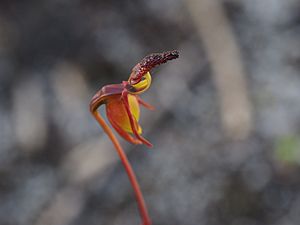Small duck orchid facts for kids
Quick facts for kids Small duck orchid |
|
|---|---|
 |
|
| Caleana nigrita growing near Yallingup | |
| Scientific classification | |
| Genus: |
Caleana
|
| Species: |
nigrita
|
| Synonyms | |
|
|
The Caleana nigrita, also known as the small duck orchid or flying duck orchid, is a special type of orchid. It grows only in the south-west part of Western Australia. This orchid is the most common of the "flying duck" orchids and can be found in more places than other types in Western Australia.
It has one smooth leaf. You can tell it apart from other duck orchids by its labellum, which is a special part of the flower. This labellum has a small hump in the middle. Also, tiny bumps called calli cover about two-thirds of its outer end. Because of its dull colors, it can be hard to spot, especially in areas that have recently had a bushfire.
Contents
What Does the Small Duck Orchid Look Like?
The Caleana nigrita has a single, smooth leaf that can be green or red. This leaf is usually about 10 to 30 millimeters (0.4 to 1.2 inches) long. It is also about 7 to 11 millimeters (0.3 to 0.4 inches) wide.
The plant grows one or two flowers on a stalk. This stalk can be 50 to 150 millimeters (2 to 6 inches) tall. The flowers are greenish-yellow and red. They are about 16 to 27 millimeters (0.6 to 1.1 inches) long and 9 to 16 millimeters (0.4 to 0.6 inches) wide.
The top part of the flower, called the dorsal sepal, hangs downwards. The side parts, called lateral sepals and petals, also hang down. The dorsal sepal presses against the column, which has wide wings. This creates a shape that looks a bit like a bucket. The outer two-thirds of the labellum are covered with shiny black bumps or glands. There is also a small hump in the middle of the labellum. These orchids usually bloom from August to October.
How the Small Duck Orchid Got Its Name
The small duck orchid was first officially described in 1840. A botanist named John Lindley wrote about it. He used some notes from another botanist, James Drummond. Drummond had given it the name Caleana nigrita. Lindley then published this description.
Later, in 1972, a scientist named Donald Blaxell tried to change its name to Paracaleana nigrita. However, many plant experts did not agree with this change. In 1989, Mark Clements pointed out that the differences between Paracaleana and Caleana were not big enough to make them two separate groups of plants. So, it is still mostly known as Caleana nigrita.
The second part of its scientific name, nigrita, comes from a Latin word. It means "blackened," which probably refers to the dark, glossy bumps on its labellum.
Where Does the Small Duck Orchid Live?
You can find Caleana nigrita in areas close to the coast in Western Australia. It grows between the towns of Eneabba and Esperance. It lives in several different natural regions, including the Swan Coastal Plain, Warren, Avon Wheatbelt, Esperance Plains, Jarrah Forest, and Mallee. This orchid usually grows in woodlands and areas with shrubs.
Conservation Status
The Western Australian Government's Department of Parks and Wildlife has looked at the Caleana nigrita. They have classified it as "not threatened." This means that there are enough of these orchids in the wild, and they are not currently at risk of disappearing.

